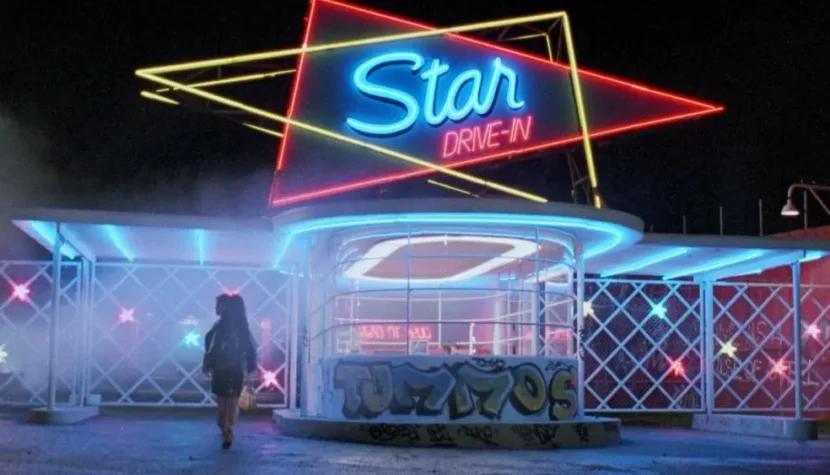“Dead End Drive-In”. One of Quentin Tarantino’s favorite science fiction films

On the poster for “Dead End Drive-In”, there’s a figure wearing makeup reminiscent of Eric Draven from “The Crow“, but this character is nowhere to be found in the actual movie. This is telling for a production trying to pass itself off as something it’s not.
The film opens with screens displaying information about events from 1988–1990: riots in Australia and South Africa resulting in hundreds of thousands of deaths, a nuclear explosion on a Pacific atoll contaminating ocean waters, a drop in gold and diamond exports, and a major Wall Street crash causing a global financial crisis, leading to inflation, supply shortages, unemployment, rising crime, and the collapse of industry. World governments form special forces to manage the chaos, but the only functioning nations left are the United States, Australia, and North Korea. In rural Australia lives a teenager named Jimmy, who one evening takes his girlfriend Carmen to a drive-in cinema. It turns out to be a trap: a government-run concentration camp for societal outcasts and unemployed youth. The inmates are fed junk food, alcohol, drugs, movies, and music. Jimmy decides to escape the prison at all costs.

Brian Trenchard-Smith is one of the leading figures of Ozploitation—a branch of exploitation cinema from Australia, typically consisting of low-budget B-movies in the action, horror, science fiction, and comedy genres. Among the best-known “works” by the Anglo-Australian filmmaker are “The Man from Hong Kong” (1975), “Turkey Shoot” (1982), and “BMX Bandits” (1983). Since the 1990s, Trenchard-Smith has mainly directed productions for television and the home video market, including films with telling titles such as “Leprechaun 4” (1996), “Atomic Dog” (1998), and “Doom Runners” (2003). These kinds of cinematic trash have fans worldwide, one of the most famous being Quentin Tarantino, who revealed that “Dead End Drive-In” is his favorite Trenchard-Smith film and one of his favorite science fiction movies. No surprise there: the film is perfect grindhouse material.
The film’s script is based on the short story “Crabs” by Australian writer Peter Carey (who would later co-write the script for Wim Wenders’ “Until the End of the World” [1991]), though Trenchard-Smith admitted he never read it. He was handed the directorial reins for “Dead End Drive-In” after the original director left the project. The film was shot at a drive-in theater in Matraville, a suburb of Sydney, with filming lasting just over a month. The budget, amounting to 2.5 million Australian dollars, was provided by the New South Wales Film Corporation but never recouped: when the movie hit Australian theaters in August 1986, ticket sales amounted to just 68,000 in the same currency. That’s less than stuntman Guy Norris earned for his world-record 49-meter car jump in the film’s finale, which earned him 75,000. The box office failure of “Dead End Drive-In” crushed Trenchard-Smith’s plans for a sequel.

Brian Trenchard-Smith referenced “The Exterminating Angel” (1962) by Luis Buñuel and “Mad Max” (1979) by George Miller, suggesting that “Dead End Drive-In” was a blend of social satire and dystopian post-apocalyptic cinema. “The film is, of course, an allegory of the junk values of the 1980s, which our protagonist sees as a prison,” the director said. What makes up these “junk values”? Are they hamburgers, legal and illegal intoxicants, new wave music, and the movies watched by the young prisoners of the cinema-camp? If so, Trenchard-Smith included not just a critique of pop culture but also self-criticism, as the drive-in screens his own films: “The Man from Hong Kong” and “Turkey Shoot”! Is the director implying that he’s one of the creators of these “junk values”? Is his film a kind of confession from a maker of cheap, mind-numbing B-movies?
That seems doubtful, given Trenchard-Smith’s career trajectory. His explanations regarding “Dead End Drive-In” come across as intellectual gymnastics trying to give depth to a film that’s quite shallow. While “Dead End Drive-In” is competently made (the cinematography and set design are especially good), beneath the interesting form lies little substance—unless someone considers a diatribe against fast food and pop music to be deep commentary. The director pretends to be “fighting the good fight” by adding a subplot about racists, but it’s never developed and has no real connection to the already weak storyline. Nothing much happens in the film: Jimmy endlessly roams around the area, trying to figure out how to escape the cinema (which resembles a decadent festival more than a dangerous penal colony), but his struggles lack tension or a sense of threat. Jimmy himself is so bland that it’s hard to care about his fate. A questionable form of entertainment.

